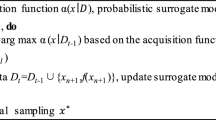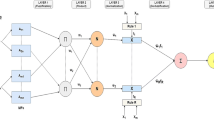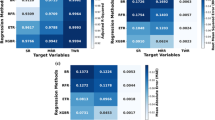Abstract
Machining of new superalloys is challenging. Automated software environments for determining the optimal cutting conditions after reviewing a set of experimental results are very beneficial to obtain the desired surface quality and to use the machine tools effectively. The genetically optimized neural network system (GONNS) is proposed for the selection of optimal cutting conditions from the experimental data with minimal operator involvement. Genetic algorithm (GA) obtains the optimal operational condition by using the neural networks. A feed-forward backpropagation-type neural network was trained to represent the relationship between surface roughness, cutting force, and machining parameters of face-milling operation. Training data were collected at the symmetric and asymmetric milling operations by using different cutting speeds (V c), feed rates (f), and depth of cuts (a p) without using coolant. The surface roughness (Raasymt, Rasymt) and cutting force (Fxasymt, Fyasymt, Fzasymt, Fxsymt, Fysymt, Fzsymt) were measured for each cutting condition. The surface roughness estimation accuracy of the neural network was better for the asymmetric milling operation with 0.4% and 5% for training and testing data, respectively. For the symmetric milling operations, slightly higher estimation errors were observed around 0.5% and 7% for the training and testing. One parameter was optimized by using the GONNS while all the other parameters, including the cutting forces and the surface roughness, were kept in the desired range.
Similar content being viewed by others
References
Agarwal SC, Ocken H (1990) The microstructure and galling wear of a laser-melted cobalt-base hardfacing alloy. Wear 140:223–233
Crook P (1993) Properties and selection: non-ferrous alloys and special-purpose materials 2 (10). Metals handbook, ASM Int., USA, 446
Murray JD, McAlister AJ (1984) Bulletin in alloy phase diagrams, 5:90
Aykut Ş (2005) The investigation of effects of machinability on chip removal parameters for face milling of cobalt-based superalloy steels. Marmara University Institute of Science & Technology, Ph.D. thesis
Kuzucu V, Ceylan M, Celik H, Aksoy İ (1997) Microstructure and phase analyses of Stellite plus 6 wt.% Mo alloy. J Mater Process Technol 69:257–263
Mohamed KE, Gad MMA, Nassef AE, El-Sayed AW (1999) Localized behavior of powder metallurgy processed cobalt-based alloy Stellite 6 in chloride environments. Z Met kd 90:195–201
Ozcelik B, Bayramoglu M (2006) The statistical modeling of surface roughness in high-speed flat end milling. Int J Mach Tools Manuf 46:1395–1402
Diniz AE, Filho JC (1999) Influence of the relative positions of tool and workpiece on tool life, tool wear and surface in the face milling process. Wear 232:67–75
Altıntaş Y (2000) Manufacturing automation. Cambridge University Press, New York, pp 5–6
Bezce CE, Elbestawi MA (2002) A chip formation based analytic force model for oblique cutting. Int J Mach Tools Manuf 42:529–538
Peigne G, Paris H, Brissaud D, Gouskov A (2004) Impact of the cutting dynamics of small radial immersion milling operations on machined surface roughness. Int J Mach Tools Manuf 44:1133–1142
Franco P, Estrems M, Fuara F (2004) Influence of radial and axial run outs on surface roughness in face milling with round insert cutting tools. Int J Mach Tools Manuf 44:1555–1565
Kishawy HA, Dumitrescu M, Ng EG, Elbestawi MA (2005) Effect of coolant strategy on tool performance, chip morphology and surface quality during high-speed machining of A356 aluminum alloy. Int J Mach Tools Manuf 45:219–227
de Souza M, Jr SWF, Santosc SC, Machadod AR (2005) Performance of single Si3N4 and mixed Si3N4CPCBN wiper cutting tools applied to high speed face milling of cast iron. Int J Mach Tools Manuf 45:335–344
Ertakin YM, Kwon Y, Tseng TL (2003) Identification of common sensory features for the control of CNC milling operations under varying cutting conditions. Int J Mach Tools Manuf 43:897–904
Fuht KH, Wu CF (1995) A proposed statistical model for surface quality prediction in end-milling of Al alloy. Int J Mach Tools Manuf 35:1187–1200
Dabade UA, Joshi SS, Ramakrishnan N (2003) Analysis of surface roughness and cross-sectional area while machining with self propelled round inserts milling cutter. J Mater Process Technol 132:305–312
Saglam H, Unuvar A (2003) Tool condition monitoring in milling based on cutting forces by a neural network. Int J Prod Res 41:1519–1532
Benardos PG, Vosniakos GC (2003) Predicting surface roughness in machining: a review. Int J Mach Tools Manuf 43:833–844
Balic J, Korosec M (2002) Intelligent tool path generation for milling of free surfaces using neural networks. Int J Mach Tools Manuf 42:1171–1179
Ozcelik B, Oktem H, Kurtaran H (2005) Optimum surface roughness in end milling Inconel 718 by coupling neural network model and genetic algorithm. Int J Adv Manuf Technol 27:234–241
El-Wahab AI, Kishawy HA (2000) A new method to improve the surface quality during CNC machining. Int J Prod Res 38:3711–3723
Baek DK, Ko TJ, Kim HS (1997) A dynamic surface roughness model for face milling. Precis Eng 20:171–178
Amiolemhen PE, Ibhadode AOA (2004) Application of genetic algorithms—determination of the optimal machining parameters in the conversion of a cylindrical bar stock into a continuous finished profile. Int J Mach Tools Manuf 44(12/13):1403–1412
Tansel IN, Bao WY, Arkan TT, Kropas-Hughes CV (2002) Genetic algorithm versus neural network in health monitoring applications. Intelligent Engineering Systems Through Artificial Neural Networks 12:255–260
Tansel IN, Bao WY, Reen NS, Kropas-Hughes CV (2005) Genetic tool monitor (GTM) for micro-end-milling operations. Int J Mach Tools Manuf 45:293–299
Cus F, Balic J (2003) Optimization of cutting process by GA approach. Robot Comput-Integr Manuf 19(1–2):113–121
Davim JP, Anto´nio CAC (2001) Optimisation of cutting conditions in machining of aluminium matrix composites using a numerical and experimental model. J Mater Process Technol 112(1):78–82
Khan Z, Prasad B, Singh T (1997) Machining condition optimization by genetic algorithms and simulated annealing. Comput Oper Res 24(7):647–657
Brezocnik M, Kovacic M (2003) Integrated genetic programming and genetic algorithm approach to predict surface roughness. Mater Manuf Process 18(3):475–491
Chien WT, Tsai CS (2003) The investigation on the prediction of tool wear and the determination of optimum cutting conditions in machining 17-4PH stainless steel. J Mater Process Technol 140(1/3):340–345
Tansel IN, Ozcelik B, Baoa WY, Chena P, Rincona D, Yanga SY, Yenilmez A (2006) Selection of optimal cutting conditions by using GONNS. Int J Mach Tools Manuf 46:26–35
Yang SY, Tansel IN, Kropas-Hughes CV (2003) Selection of optimal material and operating conditions in composite manufacturing. Part I: computational tool. Int J Mach Tools Manuf 43:169–173
Yang SY, Girivasan V, Singh NR, Tansel IN, Kropas-Hughes CV (2003) Selection of optimal material and operating conditions in composite manufacturing. Part II: complexity, representation of characteristics and decision making. Int J Mach Tools Manuf 43:175–184
Tansel I N, Yang S Y, Shu C, Bao W Y, Mahendrakar N, Dagli C H, Akay M, Buczak A L, Ersoy O, Fernandez (Eds.) B 1999 Introduction to genetically optimized neural network systems (GONNS). Smart engineering systems: neural networks, fuzzy logic, evolutionary programming, data mining, and rough sets, ASME, New York, 331–336
ISO 8688-1 (1989) Tool life testing in milling, part I, face milling, 1st edition
Lou MS, Chen JC, Li CM (1999) Surface roughness prediction technique for CNC end milling. J Ind Technol 15(1):1–6
Yang JL, Chen JC (2001) A systematic approach for identifying optimum surface roughness performance in end-milling operations. J Ind Technol 17(2):1–8
Bağcı E, Aykut Ş (2006) A study of Taguchi optimization method for identifying optimum surface roughness in CNC face milling of cobalt-based alloy (stellite 6). Int J Adv Manuf Technol 29:940–947
Author information
Authors and Affiliations
Corresponding author
Rights and permissions
About this article
Cite this article
Aykut, Ş., Demetgul, M. & Tansel, I.N. Selection of optimum cutting condition of cobalt-based superalloy with GONNS. Int J Adv Manuf Technol 46, 957–967 (2010). https://doi.org/10.1007/s00170-009-2165-x
Received:
Accepted:
Published:
Issue Date:
DOI: https://doi.org/10.1007/s00170-009-2165-x




